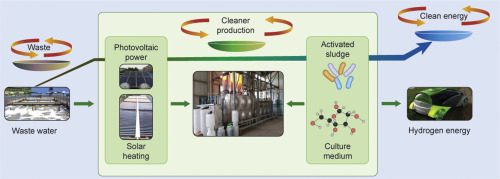Journal of Cleaner Production ( IF 11.1 ) Pub Date : 2019-04-25 , DOI: 10.1016/j.jclepro.2019.04.233 Chaoyang Lu , Yi Wang , Duu-Jong Lee , Quanguo Zhang , Huan Zhang , Nadeem Tahir , Yanyan Jing , Hong Liu , Kai Zhang

|
Systematic investigation of the effects of hydraulic retention time and substrate concentration on biohydrogen production rates in pilot-scale fermenter is of great academic and practical interests. The present study applied a 3 m3 pilot-scale bioreactor that composed of three sequential 1 m3 chambers (#1-#3) to investigate the effects of hydraulic retention time and substrate concentration on biohydrogen production rates from glucose. The 48 h hydraulic retention time resulted in poor mixing of the medium; chamber #1, which received the feed substrate, converted too much glucose, and little glucose was left to be utilized in the following chambers. However, a 12 h hydraulic retention time allowed insufficient volatile fatty acids to be produced, so a reductive environment for biohydrogen production was difficult to establish. At the optimal hydraulic retention time, 24 h for the present fermenter, sufficient mixedness of the medium and fermentation times for all chambers maximized the biohydrogen production rates. Biohydrogen production rates were increased as the substrate concentration was increased from 10 to 30 g/L, peaked at 100.16 mol/m3-d, and then decreased with the increase in substrate concentration. Unique in the literature, the reported data reveal the effects of substrate concentration on biohydrogen production rates in pilot-scale fermenter, guiding to the design and development of the pilot-scale bioreactors with high hydrogen yields that could help to improve the industrialization development of biohydrogen production.
中文翻译:

中试规模发酵罐中的生物氢生产:水力停留时间和底物浓度的影响
对中试规模的发酵罐中水力停留时间和底物浓度对生物氢生产率的影响进行系统研究具有重大的学术和实践意义。本研究应用了一个3 m 3中试规模的生物反应器,该反应器由三个连续的1 m 3组成室(#1-#3),研究水力停留时间和底物浓度对葡萄糖产生生物氢的速率的影响。48 h的水力停留时间导致培养基混合不良。接收进料底物的#1腔室转化了过多的葡萄糖,剩下的葡萄糖很少,无法在随后的腔室中利用。但是,水力停留时间为12 h使得挥发性脂肪酸的产生不足,因此难以建立用于生产生物氢的还原性环境。对于本发酵罐,在最佳水力停留时间(24小时)下,所有室的培养基充分混合和发酵时间可使生物氢产生速率最大化。随着底物浓度从10 g / L增加到30 g / L(峰值为100),生物氢生产率提高。3- d,然后随着底物浓度的增加而降低。在文献中独特的是,报道的数据揭示了底物浓度对中试规模发酵罐中生物氢生产率的影响,为设计和开发具有高氢产率的中试生物反应器提供了指导,这可能有助于改善生物氢的工业化发展生产。


























 京公网安备 11010802027423号
京公网安备 11010802027423号